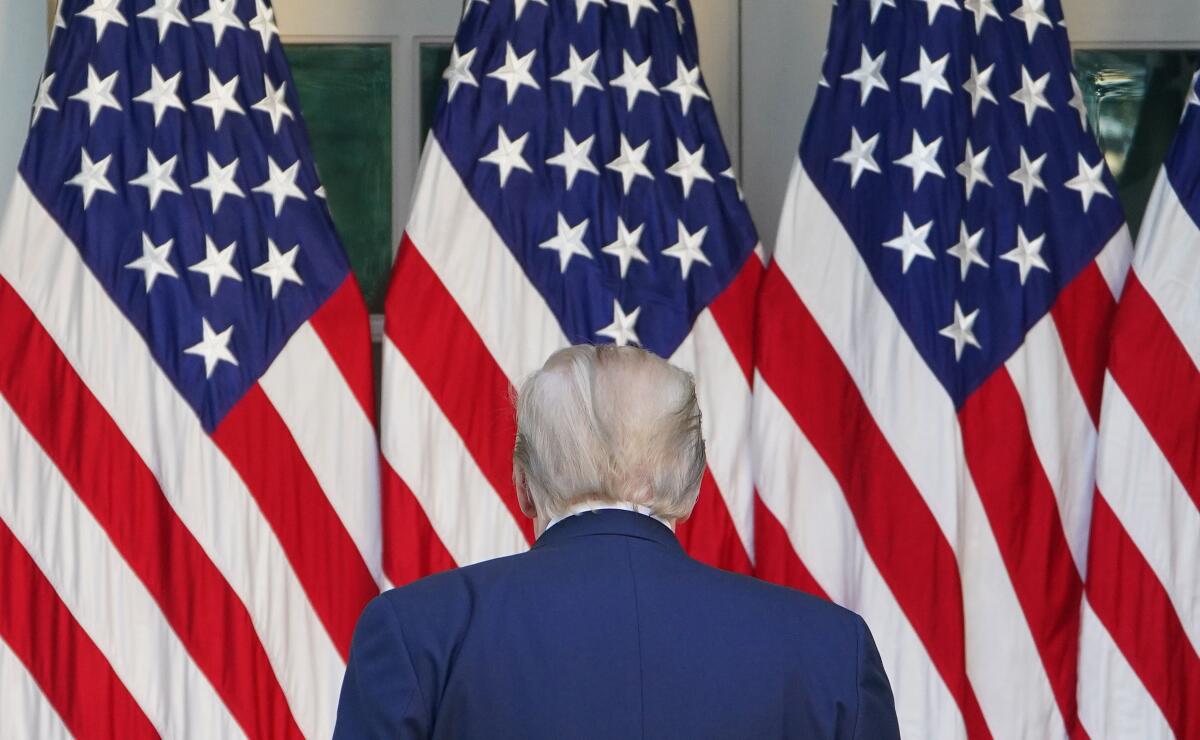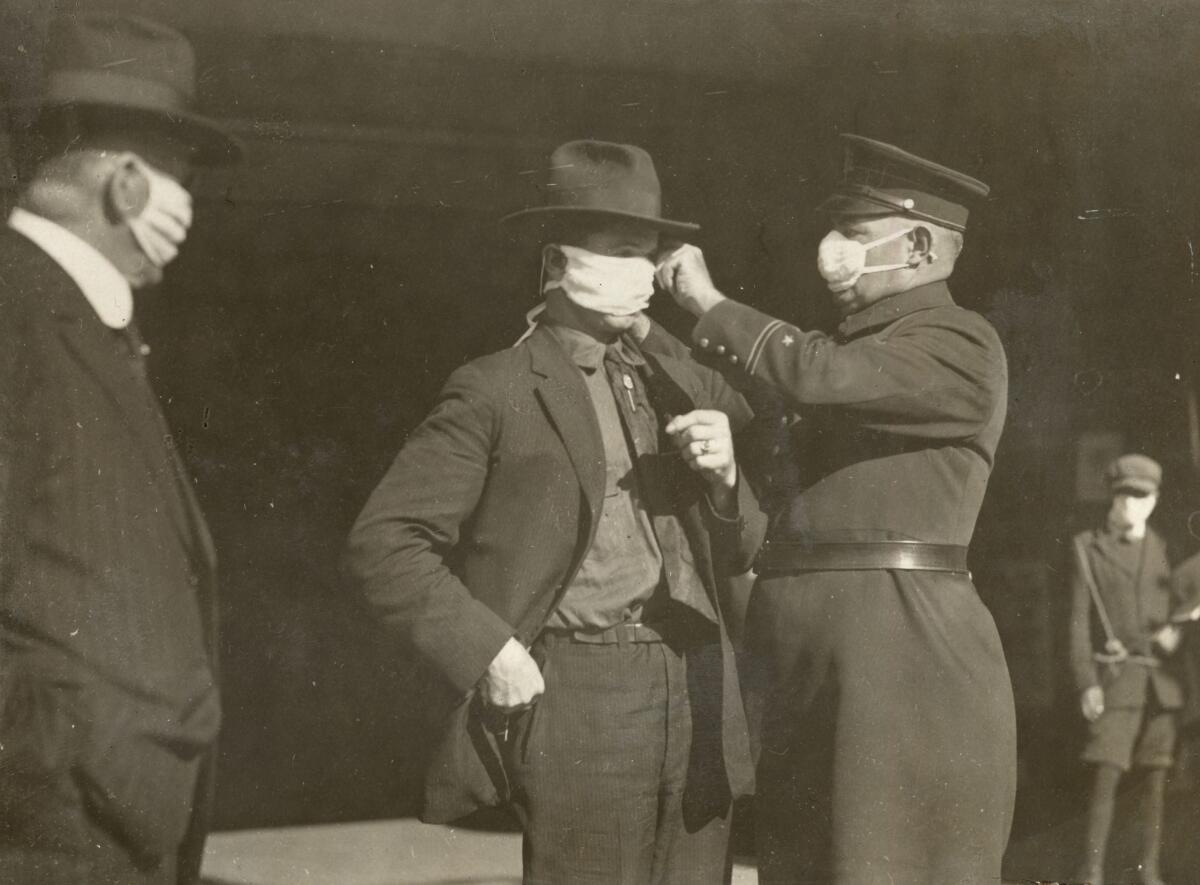Newsletter: How the U.S. fell behind the curve

- Share via
President Trump’s unwillingness to take the coronavirus threat seriously and disagreements among his top aides resulted in lost weeks.
TOP STORIES
How the U.S. Fell Behind the Curve
President Trump has at various times called the coronavirus catastrophe unforeseeable or blamed the World Health Organization, China, former President Obama and state governors.
But from the first international reports of the virus’ appearance in China in late December until Trump declared a nationwide emergency in mid-March, his administration delayed or bungled basic but crucial steps to contain the spread of infections and prepare the United States for a pandemic, according to a Times review of internal government records and interviews with administration officials and outside experts.
In that key early period, many of the Trump presidency’s most deeply ingrained characteristics — its distrust of the federal bureaucracy, internal personality conflicts, lack of a formal policymaking process and Trump’s own insistence on controlling the public message — severely hampered the federal response, according to current and former White House officials and public health experts.
Even senior members of the administration who sought to warn Trump about the looming dangers were rebuffed, said several administration officials who spoke on condition of anonymity because they were not authorized to comment on internal discussions. The White House said in a statement that Trump acted to control the virus while Democrats in Congress and the news media ignored the danger in January and February.
Now, the U.S. leads the world in reported numbers of people infected and killed by the virus, with more than 40,000 dead. States, counties and local hospitals are desperately bidding against one another for scarce ventilators and other lifesaving equipment in a marketplace dominated by chaos, profiteering and fraud. And the country’s economy is in free fall, with roughly 22 million Americans having filed unemployment claims in the last month.
Start your day right
Sign up for Essential California for the L.A. Times biggest news, features and recommendations in your inbox six days a week.
You may occasionally receive promotional content from the Los Angeles Times.
More Help on the Way?
In another planned round of financial assistance, the Trump administration and congressional Democrats expressed optimism that more than $450 billion in loans and aid to Americans most affected by the coronavirus outbreak will be enacted this week. The bulk of the money would be aimed at helping small-business owners, many of them pushed to collapse by the weekslong shutdown of bars, restaurants, shops and other businesses in much of the country.
The package would also earmark $25 billion for coronavirus testing, which has become a major point of contention between Trump and the nation’s governors, and $75 billion for beleaguered hospitals, Treasury Secretary Steven T. Mnuchin said. House Speaker Nancy Pelosi and Senate Minority Leader Charles E. Schumer agreed that a deal was close.
But the two sides were still struggling Sunday to reconcile differences over whether to add aid to states and municipalities, which Democrats said would provide a lifeline for first responders and workers such as bus drivers who are in close contact with the public.
The Senate plans to hold a brief session this afternoon, during which the Republican and Democratic leaders could pass the deal if no single senator objects. The House is slated to hold a similar brief session Tuesday.
Trying to Follow the Money
Oversight systems are still largely dormant for the $2 trillion in coronavirus economic relief passed by Congress last month, leaving gaping holes in accountability just as the Treasury Department prepares to give hundreds of billions of dollars in aid to corporations.
The coronavirus response package was the largest in U.S. history, and lawmakers wanted to ensure adequate checks and supervision of the massive funding. But with no less than four oversight bodies now struggling to get up and running, and Congress functioning remotely because of the pandemic, lawmakers acknowledge deficiencies.
The biggest area of concern for Democrats is the nearly $500-billion fund that the Treasury Department — with significant control by Mnuchin — will use to buoy corporations. Complicating matters is Trump, who said as he signed the act into law that he would not abide by some of the oversight rules.
The State of the City Is ‘Under Attack’
In his annual State of the City address, L.A. Mayor Eric Garcetti warned that the economic downturn will be more painful than the 2008 recession, requiring cuts to government programs and the furlough of thousands of city employees.
“I’ve never before hesitated to assure you that our city is strong,” he said. “But I won’t say those words tonight. Our city is under attack. Our daily life is unrecognizable.
“We are bowed and we are worn down. We are grieving our dead,” the mayor continued, choking back tears. “But we are not broken.”
The city has already borrowed $70 million from special funds while responding to the health crisis. To balance the city budget, civilian city workers will need to take off 26 unpaid days — the equivalent of a 10% reduction in pay, the mayor said. So far, the city’s political leaders sounded open to the reductions being sought by Garcetti.
More Top Coronavirus Headlines
— Trump has been defending protests against coronavirus restrictions, claiming some governors had overreached in their efforts to fight the pandemic — efforts that were based on the advice of leading health officials in his own administration. National polls indicate that the protesters do not reflect most Americans’ views.
— Although California is seeing the rate of new infections from the coronavirus declining, Gov. Gavin Newsom said rising death counts are a major concern. As for lifting some stay-at-home orders, Newsom added: “We are going to do the right thing, not judge by politics, not judge by protests, but by science.”
— For the first time, California Department of Public Health officials have divulged the names of nursing homes with COVID-19 outbreaks and the number of cases at each facility. Among the hardest-hit: the Brier Oak on Sunset nursing home in L.A.
— Local restaurants and other small businesses are wondering: Where’s the money from the Paycheck Protection Program?
— Charity donations have taken off, but they’re also highlighting America’s deep socioeconomic divisions.
— Do testicles make men more vulnerable to the coronavirus? That’s one hypothesis researches are testing.
Plus, here are some tips on getting through the days ahead. For more, sign up for Coronavirus Today, a special edition of The Times’ Health and Science newsletter. As with all our newsletters, it’s free:
— The do’s and don’ts of wearing a face mask correctly (and comfortably).
— How to care for someone with COVID-19.
FROM THE ARCHIVES
When the Spanish flu hit Los Angeles and San Francisco in 1918, they had distinct cultures and leaders who responded to the pandemic in markedly different ways. The city in the south moved fairly quickly at the first signs of danger — shutting down bars, pool halls, sporting events and more. Its rival to the north waited at least a week longer to order closures, as its leaders banked on masks.
Yet both would make a mistake that would spur a “double hump” of contagion: loosening restrictions too soon. Here are some of the lessons from 102 years ago.

CALIFORNIA
—The L.A. Unified School District has become a mammoth food distribution operation, serving about 9.8 million meals so far at campuses and partnering with the Red Cross and the regional food bank.
— In L.A. County, many gang intervention workers are still on the streets, tending to the neighborhoods where they grew up.
— The quaint, Danish-settled town of Solvang is struggling through the stay-home orders because of its dependence on tourists.
— It’s cool today, but L.A.’s first big warm-up of spring could bring high temperatures near 90 degrees by Saturday.
Knowledge is power
Subscribe to the Los Angeles Times.
NATION-WORLD
— Authorities say a 51-year-old man wearing a police uniform went on a shooting rampage across the northern part of the Canadian province of Nova Scotia, killing at least 16 people, including a policewoman.
— In Mexico, some foreign-owned factories continue to operate despite social distancing guidelines. As the coronavirus spreads, workers have been dying.
— In Iran, one of the worst-hit countries during the pandemic, authorities have called upon people to help uphold the Islamic custom of purifying the dead before burial. That includes volunteer body washers.
— North Korea said Trump’s comment that he recently received “a nice note” from leader Kim Jong Un was “ungrounded.” In defending the now-stalled nuclear diplomay with Kim, Trump also claimed the U.S. would have been at war with North Korea if he had not been elected.
HOLLYWOOD AND THE ARTS
— The 23 most fascinating takeaways from ESPN’s Michael Jordan series, or at least from the first two episodes.
— Former First Lady Michelle Obama will be hosting a four-part series of online read-alongs for kids, starting today.
— The global concert “One World: Together at Home” brought a mix of coziness and stay-at-home splendor with Elton John, Taylor Swift, Billie Eilish, Paul McCartney, Jennifer Lopez, the Rolling Stones, Lady Gaga and more.
— “First Cow” for best picture? Critic Justin Chang offers his guide to the Oscars if movie theaters don’t reopen this year.
BUSINESS
— Walt Disney Co. will stop paying more than 100,000 employees this week, nearly half of its workforce, as the world’s biggest entertainment company tries to weather the coronavirus lockdown.
— Might as well get stoned? The cannabis business is among the few industries now seeing boom times in California.
SPORTS
— At Santa Anita Park racetrack, horse racing has been suspended, but hundreds of workers are still caring for the horses. Many live in small dorm-style rooms set in buildings near the barns.
— As much as Dodgers pitcher Clayton Kershaw would like a season, he is against any plan that would take him away from his family for several months.
Free online games
Get our free daily crossword puzzle, sudoku, word search and arcade games in our new game center at latimes.com/games.
OPINION
— This man masterminded Daniel Pearl’s abduction in 2002. Columnist Nicholas Goldberg, a friend of Pearl, explains why he shouldn’t be set free.
— Last chance to reconsider the Los Angeles County Museum of Art’s bad plan for a new museum?
WHAT OUR EDITORS ARE READING
— How does the coronavirus kill? Clinicians are seeing it attack almost anything in the body, not just the lungs. (Science)
— Jacinda Ardern, the 39-year-old prime minister of New Zealand, is seeing success in the coronavirus fight by focusing on empathy. (The Atlantic)
ONLY IN L.A.
At 76 years old, U.S. District Judge David O. Carter knows he should be at home and away from people — not in a cavernous ballroom in the basement of the Alexandria Hotel surrounded by attorneys and journalists, or outside leading a tour of the largest concentration of homeless people in the country. He says he’s taking social distancing seriously, along with wearing a mask and gloves. But Carter, long known as brash, verbose and stubbornly hands-on, has been on a mission to force changes in the living conditions for the homeless people of L.A.
Comments or ideas? Email us at headlines@latimes.com.
Sign up for Essential California
The most important California stories and recommendations in your inbox every morning.
You may occasionally receive promotional content from the Los Angeles Times.






